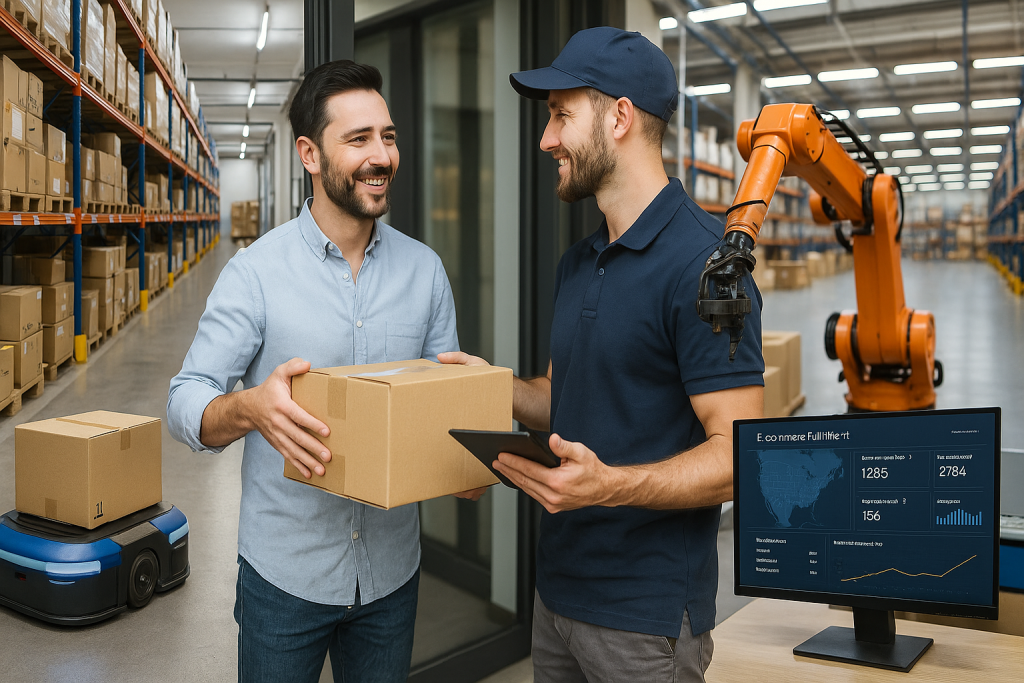By Martin Vassilev / 15 Sep, 2025
E-commerce fulfillment has quickly evolved from a back-end operational necessity to a strategic differentiator that shapes customer loyalty, profitability, and market share. As we move deeper into 2025, businesses in Canada and the U.S. face new opportunities—and challenges—in adapting to shifting consumer expectations, technological advancements, and global supply chain realities. The future of fulfillment will be defined by speed, personalization, automation, sustainability, and data-driven decision-making. Below is a comprehensive guide to the trends shaping the fulfillment industry this year and beyond.
The e-commerce sector in North America continues its double-digit growth trajectory. According to the U.S. Census Bureau, online sales now account for nearly 20% of all retail activity, with Canada following a similar path. But fulfillment—the process of storing, picking, packing, and delivering goods—has become the battleground where brands either win or lose consumer trust.
What once sufficed as “two-day shipping” is now overshadowed by expectations of same-day or even two-hour delivery in major markets like Toronto, New York, Vancouver, and Los Angeles. This rising demand requires not just physical capacity, but smarter processes, advanced technology, and innovative fulfillment strategies. Businesses that fail to adapt risk losing market share to competitors who deliver faster, more reliably, and more sustainably.
By 2025, same-day fulfillment is no longer an industry perk—it is rapidly becoming the baseline in urban centers. Retailers and third-party logistics providers (3PLs) are racing to expand micro-fulfillment centers and local hubs to meet consumer demand.
Micro-fulfillment hubs: Smaller, strategically located warehouses close to dense populations reduce last-mile costs and cut delivery windows to hours instead of days.
On-demand warehousing: Flexible on-demand warehousing services give e-commerce brands the ability to scale up or down seasonally without long-term real estate commitments.
Marketplace competition: Amazon, Walmart, and Shopify continue to drive consumer expectations, forcing smaller retailers to adapt quickly or partner with specialized fulfillment providers.
Artificial intelligence and robotics have moved from futuristic concepts to real-world fulfillment assets. By 2025, automation is no longer optional—it is a necessity for cost efficiency and scalability.
Automated storage and retrieval systems (AS/RS) are optimizing warehouse space utilization, reducing errors, and speeding up order cycles.
AI-powered forecasting enables accurate demand predictions, minimizing overstock and stockouts.
Robotic picking and packing systems increase throughput while reducing reliance on manual labor, which remains costly and volatile.
Companies that integrate AI into their operations, as highlighted in AI-driven logistics strategies, are setting new industry benchmarks for fulfillment efficiency.
Sustainability is no longer just a “nice-to-have”—it is now a purchasing factor for eco-conscious consumers across Canada and the U.S. Fulfillment operations play a significant role in achieving environmental targets.
Green warehousing practices, such as solar-powered facilities, LED lighting, and waste reduction, are gaining traction.
Eco-friendly packaging is increasingly expected, with consumers favoring recyclable, compostable, and reusable materials.
Route optimization software helps reduce carbon emissions in last-mile delivery, balancing customer convenience with environmental responsibility.
Organizations are leveraging solutions like green logistics to reduce their footprint while boosting brand reputation.
The modern consumer expects fulfillment to be tailored to their lifestyle. Beyond delivery speed, personalization in fulfillment includes customized packaging, product bundling, and convenient return options.
Flexible delivery options: Consumers increasingly demand the ability to choose delivery windows, locker pickups, or in-store pickup for convenience.
Branded unboxing experiences: Custom packaging creates a memorable customer experience, driving repeat business.
Returns optimization: Easy and transparent returns management processes are now essential for reducing cart abandonment and improving customer loyalty.
Data has become the lifeblood of modern e-commerce fulfillment. Companies that can harness their logistics and customer data will gain a competitive edge.
Predictive analytics improves inventory allocation by forecasting demand based on historical sales, seasonality, and regional trends.
Real-time tracking builds trust and transparency, with customers expecting live updates on their orders.
Data integration across platforms enables seamless synchronization between e-commerce stores, warehouses, and shipping providers.
Leaders in fulfillment are actively leveraging data analytics to streamline operations and deliver superior customer experiences.
Given the integrated trade relationship between Canada and the U.S., cross-border fulfillment is becoming a critical growth lever for e-commerce businesses.
Customs clearance automation reduces delays and ensures compliance.
Distributed fulfillment networks allow brands to store inventory on both sides of the border, reducing international shipping costs and delivery times.
Regulatory alignment remains a challenge, requiring businesses to navigate duties, tariffs, and differing tax regimes.
External sources like the U.S. International Trade Administration highlight the importance of regulatory awareness in scaling cross-border operations.

E-commerce companies are increasingly outsourcing fulfillment to specialized providers who can deliver efficiency, technology integration, and scalability.
3PL providers offer warehousing, shipping, and inventory management as a bundled service.
4PL providers go further by managing multiple 3PLs and orchestrating the entire supply chain.
Custom integrations ensure seamless data flow between e-commerce platforms like Shopify, WooCommerce, and ERP systems.
Businesses evaluating fulfillment partners can benefit from guides such as choosing the right partner, which outlines key considerations for scaling operations.
With cyber threats, theft, and supply chain disruptions on the rise, fulfillment providers are prioritizing risk mitigation.
Cybersecurity in logistics is becoming a top priority, protecting sensitive order data and payment systems.
Warehouse security measures like biometric access, surveillance, and real-time inventory tracking safeguard physical goods.
Contingency planning ensures resilience against natural disasters, strikes, or global shipping delays.
The Canadian government’s Cyber Security Centre stresses the need for digital protection in all areas of business, including fulfillment.
The e-commerce fulfillment landscape in Canada and the U.S. is entering a transformative era. Businesses that invest in automation, sustainability, personalization, and cross-border agility will thrive. Those who delay modernization risk falling behind in a market where consumer expectations are rapidly evolving. By 2025, fulfillment will no longer be a back-office function—it will be the foundation of customer trust, brand reputation, and long-term profitability.
The future of e-commerce fulfillment in Canada and the U.S. revolves around speed, intelligence, sustainability, and adaptability. Businesses that embrace these trends will unlock new efficiencies, reduce costs, and strengthen customer loyalty. The race is on, and those who lead in fulfillment innovation will secure their competitive advantage in the digital economy.
For businesses looking to enhance their fulfillment operations, explore solutions with a trusted partner. Contact ByExpress today to discover scalable, future-ready fulfillment services.

“Thanks to Byexpress all my shipping and fulfillment costs are in line now”

“All my issues were solved by Byexpress team that I had with pervious 3pl provider.”

“Thank you Byexpress team could not done it without you guys.”

“Their integration and customer service were the key for me”

“Outstanding delivery service! The package was well-packaged, and
the delivery team was professional and courteous”

“Great and knowledgeable team to work with.”

Thanks, guys, for reducing my shipping rates
Ottawa Office
2411 Holly Lane
Ottawa, ON, K1V 7P2
Toronto Office
13-280 West Beaver Creek Road Unit #136
Richmond Hill, ON, L4B 3Z1
Alexandria Office
173 Kenyon Street West
Alexandria, ON, K0C 1A0
Montreal Office
4388 Saint-Denis Street Unit #200
Montreal, QC, H2J 2L1
California Office
155 North Riverview Drive
Anaheim Hills, CA, 92808
Call Us
Toll-Free: 1-866-744-7122
Local : 613-739-3000
Email Us
Multilingual Services










